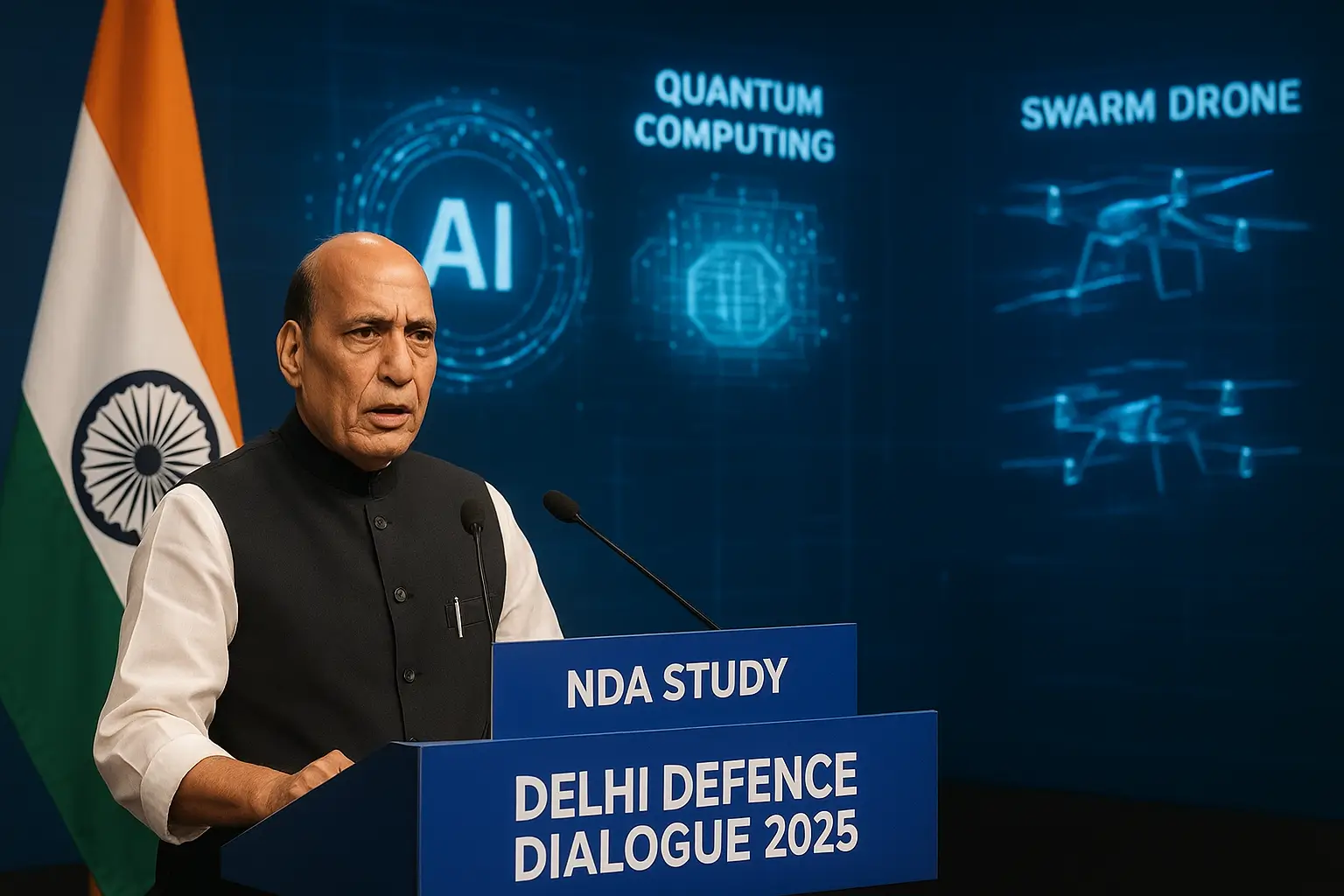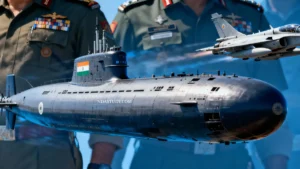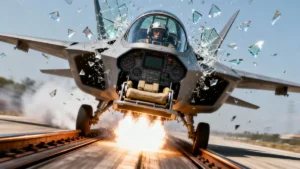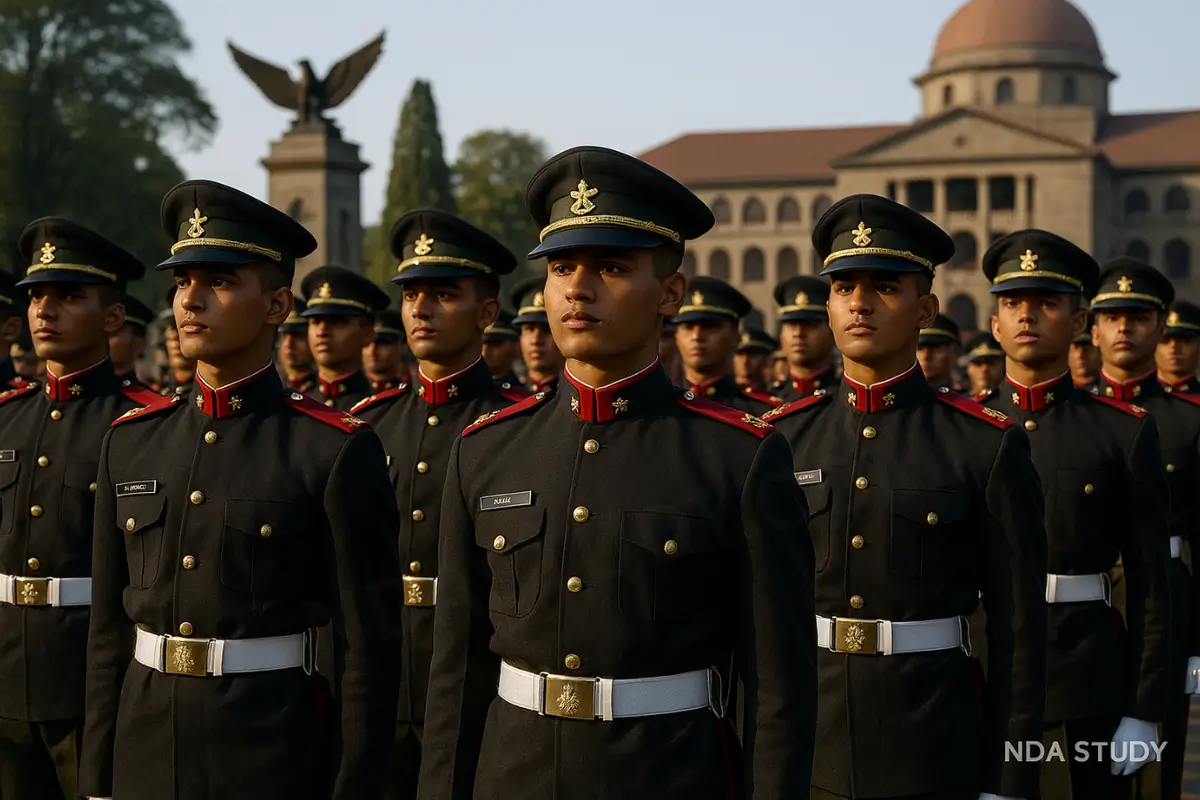On November 11, 2025, Defence Minister Rajnath Singh delivered a transformative address at the Delhi Defence Dialogue 2025, marking a pivotal shift in India’s approach to defence capability development. Speaking at the prestigious event organised by the Manohar Parrikar Institute for Defence Studies and Analyses (MP-IDSA), Singh outlined a bold vision: moving India from a consumer of defence technology to a creator and leader in next-generation warfare systems.
The Delhi Defence Dialogue 2025, held under the theme “Harnessing New Age Technology for Defence Capability Development,” unveiled India’s strategic roadmap for integrating artificial intelligence, quantum computing, and autonomous swarm systems into military operations. This isn’t just about acquiring cutting-edge equipment—it’s about transforming the entire defence ecosystem.
Delhi Defence Dialogue 2025: India’s Defence Technology Shift
Defence Minister Singh delivered a powerful message that sets the tone for India’s defence modernisation journey: “If our foundations are strong, our institutions agile, our minds open, and our collaboration seamless, then every new technological wave will not overwhelm us; it will propel us.”
India’s defence architecture has historically relied on foreign technology acquisition. The Delhi Defence Dialogue 2025 marks a decisive departure from this model. Singh articulated a four-pillar collaboration framework: soldier, scientist, startup, and strategist. This synergy represents India’s strategy to embed innovation at every level of defence planning and execution.
The stakes are high. As warfare evolves from industrial-age tactics to cyber and information-age operations, nations that master technology integration will dominate strategic autonomy. India’s vision is unambiguous—not merely adapting revolutions created elsewhere, but architecting revolutions born here.
The Three Pillars of India’s Defence Technology Revolution
The three pillars of India’s Defence Technology Revolution are as follows:
Artificial Intelligence and Machine Learning: Decision-Making at Speed
Artificial intelligence is reshaping how India’s armed forces operate. The Indian Army has already deployed 140+ AI-based surveillance systems across operational areas. These systems provide real-time threat detection, battlefield awareness, and intelligence analysis capabilities.
Beyond surveillance, AI-driven predictive analytics are revolutionising logistics and maintenance. The Army AI Centre of Excellence at Mhow is spearheading the development of autonomous threat recognition systems that enable faster decision-making than human operators alone. Operation Sindoor demonstrated how AI-integrated command and control systems can accelerate response times—a critical advantage in multi-front security scenarios.
Singh emphasised that AI must amplify human judgment, not replace it. This ethical framework distinguishes India’s approach to military technology from purely algorithmic warfare doctrines.
Quantum Computing: The Cryptography Fortress
India has achieved a breakthrough that strengthens national security immeasurably: quantum-encrypted networks. In November 2025, Indian startup QNu Labs demonstrated a 500-kilometre quantum key distribution network with the Indian Army’s Southern Command—marking India’s entry into quantum-secure military communications.
This technology is revolutionary. Traditional encryption, vulnerable to future quantum computers, faces obsolescence. India’s indigenous quantum communication capability ensures that sensitive defence data cannot be intercepted or decrypted by adversaries. The successful free-space quantum communication demonstration over 1 kilometre (June 2025) paves the way for satellite-based quantum networks linking all command centres.
Rajnath Singh’s emphasis on “indigenous software stacks” and “trusted semiconductor supply chains” reflects the critical importance of quantum tech for digital sovereignty. Control over encryption means control over operational secrets.
Swarm Drones: Autonomous Saturation Attacks
The Indian Army made history in 2023 by inducting the world’s first operational high-density swarm UAV systems. Developed by Bengaluru-based NewSpace Research & Technologies, these swarm drones operate 100 autonomous platforms per swarm, capable of coordinated strikes up to 50 kilometres inside enemy territory.
Also Read:
Each drone exhibits self-organising behaviour, collision avoidance, and AI-driven target identification with minimal human intervention. The swarms can overwhelm enemy air defences through saturation tactics—a concept that fundamentally alters offensive doctrine.
The Indian Air Force has amplified this capability by projecting requirements for 800 medium-range swarm systems (announced October 2025), each controlling 20-drone formations with a 350+ kilometre range. These aren’t theoretical concepts—they’re operational realities shaping India’s force posture.
Digital Sovereignty: Code as Indigenous as Hardware
Here lies the revolutionary concept Singh introduced at Delhi Defence Dialogue 2025: “True strategic autonomy will come only when our code is as indigenous as our hardware.” For decades, India has built defence platforms housing foreign chips, processors, and software. A foreign power could theoretically insert backdoors into algorithms controlling weapons systems. Digital sovereignty closes this vulnerability.
Singh outlined India’s approach: indigenous software stacks, homegrown AI models trained on Indian data, and trusted semiconductor supply chains. The government is promoting “invisible technologies”—secure data architectures, encrypted networks, automated maintenance systems, and interoperable databases that form the backbone of modern defence operations. This extends Aatmanirbhar Bharat (self-reliant India) from manufacturing into the digital realm. The Defence Cyber Agency (established in 2019) and emerging initiatives operationalise this vision.
For NDA aspirants and young defence professionals, this signals a crucial shift: future officers must understand cybersecurity, data architecture, and AI ethics alongside traditional warfare tactics.iDEX and TDF: Democratising Defence Innovation
India’s defence transformation isn’t imposed top-down. Instead, two programmes catalyse grassroots innovation:
Innovations for Defence Excellence (iDEX), launched in 2018, has fundamentally changed how India develops military technology. With a budget of ₹498.78 crore, iDEX supports startups, MSMEs, and innovators through:
- SPARK grants up to ₹1.5 crore (₹10 crore for iDEX Prime ventures)
- 650+ winners as of October 2025
- ₹3,000+ crore in prototype procurements integrated into armed forces
- 20+ partner incubators at IITs, IISc, and premier institutions
This is revolutionary for Indian defence culture. Traditionally, innovation flowed through bureaucratic DRDO channels. iDEX opened defence procurement to India’s vibrant startup ecosystem—NewSpace Research’s swarm drones, QNu Labs’ quantum tech, and dozens of other startups developed solutions faster than conventional defence R&D cycles.
Technology Development Fund (TDF), managed by DRDO, funds projects from concept to operational deployment. Supporting MSMEs with grants up to 90% of project cost (capped at ₹50 crore), TDF targets technology readiness level upgradation and import substitution.
These dual initiatives create a virtuous cycle: startup innovation → prototype funding → armed forces integration → export potential.
The Institutional Transformation
Singh repeatedly emphasised that technology isn’t merely hardware. True capability development requires institutional agility, transparent procurement processes, and lifecycle cost management. The armed forces are importing best global practices—not just best equipment—across training, logistics, and command systems.
Defence production surged to ₹1.51 lakh crore in FY 2024-25 (90% growth since FY 2019-20), with private sector contributions rising 28% year-on-year. Two Defence Industrial Corridors (Uttar Pradesh and Tamil Nadu) anchor this manufacturing renaissance. India’s first defence manufacturing plant in Morocco (September 2025) signals aspirations as a global defence exporter, not merely domestic supplier.
Strategic Implications: India’s Defence Future
By 2030-2035, envisioned under Mission Sudarshan Chakra, India’s defence forces will be fundamentally transformed:
- Multi-domain operations seamlessly integrating land, air, sea, space, and cyber capabilities
- AI-driven command and control enabling decisions faster than adversaries
- Quantum-encrypted networks ensuring operational security
- Swarm autonomous systems providing force multipliers in manpower-constrained scenarios
- Indigenous technology stacks eliminating foreign dependencies
This transformation addresses India’s strategic reality: facing two-front security challenges while maintaining strategic autonomy against great power competition. Technology-intensive force structures compensate for demographic challenges and extend deterrence.
For NDA aspirants, this signals a profound shift in officer training requirements. Future leaders will need technical literacy, data analytics understanding, and ethical frameworks for autonomous weapons systems—skills that transcend traditional military education.
The Vision: “Soldiers, Scientists, Startups, and Strategists”
Singh’s four-pillar framework represents India’s unique approach. Unlike authoritarian nations building top-down military-tech monopolies, India harnesses entrepreneurial energy, institutional research, strategic planning, and operational insights simultaneously.
This democratisation of defence innovation is itself a strategic advantage. Nations with centralised decision-making often miss innovations emerging from unconventional quarters. India’s framework ensures that a teenager coding in Bengaluru, a researcher at DRDO, an armed forces officer with tactical insights, and a strategic planner all contribute to capability development.
The result: ₹23,000+ crore in defence exports in FY 2024-25, up from negligible figures a decade ago. India isn’t just building for itself; it’s becoming a trusted defence technology partner for like-minded democracies.
FAQs|Delhi Defence Dialogue 2025
1. What is Delhi Defence Dialogue 2025 and why is it significant?
Delhi Defence Dialogue 2025 is a flagship annual conference organised by Manohar Parrikar Institute for Defence Studies and Analyses (MP-IDSA) held November 11-12, 2025. Defence Minister Rajnath Singh’s keynote address outlined India’s transformative strategy for integrating AI, quantum computing, and autonomous systems into military operations—signalling a shift from technology consumer to technology creator status.
2. What technologies did Rajnath Singh emphasise at Delhi Defence Dialogue 2025?
Singh highlighted three pillar technologies: artificial intelligence and machine learning for real-time battlefield awareness (140+ Army systems deployed), quantum computing for encrypted defence networks (500km network demonstrated November 2025), and swarm drone autonomous systems (100-drone operational capability, IAF seeking 800 systems).
3. What does digital sovereignty mean in India’s defence context?
Digital sovereignty means India’s complete control over algorithms, data, and chips powering defence systems. Singh stated: “True strategic autonomy will come only when our code is as indigenous as our hardware.” This includes indigenous software stacks, trusted semiconductors, and AI models trained on Indian data—eliminating foreign backdoor vulnerabilities.
4. How has iDEX revolutionised Indian defence innovation?
iDEX (Innovations for Defence Excellence) democratised defence technology by connecting startups and MSMEs with Armed Forces’ needs. With 650+ winners and ₹3,000+ crore in prototype procurements since 2018, iDEX transformed India from technology consumer to creator, with ventures like NewSpace Research (swarm drones) and QNu Labs (quantum networks) proving the model’s success
5. What is the future of Indian defence forces based on DDD 2025 vision?
By 2030-2035, India’s forces will feature AI-driven command and control, quantum-encrypted networks, multi-domain autonomous systems, and 100% indigenous technology stacks. The soldier-scientist-startup-strategist synergy outlined at Delhi Defence Dialogue 2025 will drive this transformation, making India a global defence technology leader.
Blueprint for Defence Transformation
The Delhi Defence Dialogue 2025 wasn’t merely a conference—it was a strategic inflexion point. Rajnath Singh articulated a vision where technology serves national security, where indigenous innovation replaces foreign dependence, and where India’s civilisational wisdom meets cutting-edge modernity.
“Every new technological wave will propel us, not overwhelm us,” Singh declared. This optimism isn’t naive. It’s grounded in iDEX’s 650+ winners, the world’s first operational swarm drones, India’s quantum communication breakthroughs, and a defence production ecosystem growing at double-digit rates.
For defence enthusiasts, NDA aspirants, and policymakers, the message is clear: India’s defence future will be defined not by what it buys, but by what it builds. The Delhi Defence Dialogue 2025 marked the beginning of that transformation. As India marches toward technological self-reliance in defence, the soldier-scientist-startup-strategist synergy outlined at this landmark event will shape the nation’s security for decades to come.












